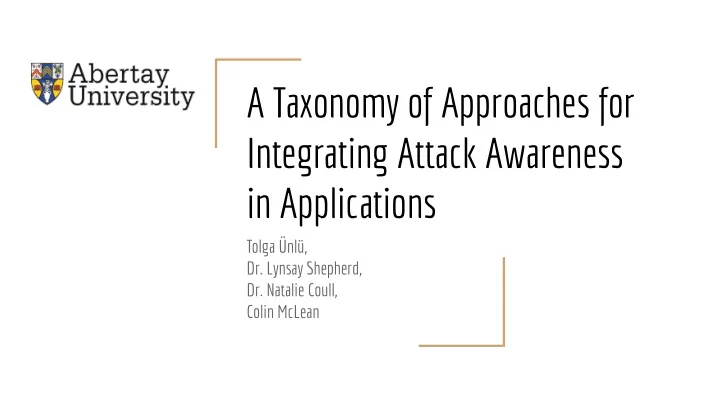

A Taxonomy of Approaches for Integrating Attack Awareness in Applications Tolga Ünlü, Dr. Lynsay Shepherd, Dr. Natalie Coull, Colin McLean
Introduction - Tolga Ünlü 1. Year PhD Student @ Abertay University, Scotland ● Supervisors: Dr. Lynsay Shepherd, Dr. Natalie Coull, Colin McLean PhD Research Project: ● Investigating Attack Awareness within Web Applications Research Interests: ● Application Security, Usable Security for Developers, Deception Technology
Agenda Problem Statement ● Attack Aware Applications ● Integration Approaches ● - Developer-Driven - Agent-Driven Discussion ● Conclusion & Future Work ●
The Security Blind Spous of Applications Applications are often built without a means of observing and reacting to security events as they occur. [1][2] This has the following consequences for applications that are blind towards security events: Attackers probing as they wish → Finding exploitable vulnerabilities ● In Production: No measure of effectivity of security controls ● In Production: No measure of validity of the threat model ● Incident Response: Missing forensic evidence ●
Attack-Aware Applications Attack-aware applications detect and respond to attacker activities in real-time through embedded detectors [3] or detection points [1]. Detectors: Security controls that check for indicators of attacker activity. if(attack_indicator){ log(“Attacker activity detected!”); respond(); }
Attack-Aware Applications The application context can be utilized to define a set of observable attack indicators for application-level intrusion detection [4]. In the current context: What actions are possible? ● Determine and Monitor Which values can a user provide? ● Security Invariants What is the expected exec. order of ● actions? “X must always be true/false” Should this action be executed at all? ● Which user roles are required for the ● actions? ... ●
Approaches for Attack Awareness Integration Guidance for researchers and developers to determine the appropriate solution based on their technical and usability requirements
Developer-Driven Integration The integration of attack awareness is done manually by the developers of an application + Utilization of Application Expertise Manual Integration and Frameworks Detectors are directly implemented + Business Logic Attack/Probing in the application code Detection + Usable Security Control Format Aspect-Oriented Programming Detectors are implemented as - Additional Task for Developers “aspects” - Security Expertise Required for → Run aspect before/after function Certain Attacks (e.g. Injection Attacks) of interest @ runtime - Manual / Limited Automation
Agent-Driven Integration The integration of attack awareness is done automatically by a software agent on behalf of the developer Runtime Environment Instrumentation + Low Setup Cost (Plug & Play) Software agent is part of the runtime + Automatic Injection Attack Detection environment → Affects all running + No Code Modification Required applications - Inadequate Detection Techniques Binary Instrumentation - Platform/Technology Specific Software agent injects detectors into - Inadequate in Certain Environments an applications binary code
Discussion Detectors for business logic attacks and probing behavior need to be manually implemented due to their custom nature. → Detecting a few distinct attacker probes could be sufficient to mitigate further attacks Detectors for these: Are a few lines of code at most (including response logic) ● Don’t introduce significant complexity ● Are performant as they execute only when attackers run into them ● But requires manual development and is an additional task on top of others. [5]
Conclusion & Future Research Attack awareness can be integrated in applications using a developer-driven or agent-driven approach. Further research will focus on reducing the integration effort and aligning the integration with common practices. Utilizing Application Frameworks and their Components → Form the Basis of many Applications → Reusable Components for Common Practices (e.g. Integrating Attack Awareness via Dependency Injection [6]) → Mitigations within the Framework increase Applications Security [7] → Frictionless for Developers
Thank you! Contact, Feedback, Collaboration: tolgadevsec.github.io
References [ 1 ] C. Watson, M. Coates, J. Melton, and D. Groves. Creating Attack-Aware Software Applications with Real-Time Defenses . 24:14–18, 2011. [ 2 ] A10:2017-Insufficient Monitoring and Logging | OWASP , 2017. https://owasp.org/www-project-top-ten/OWASP_Top_Ten_2017/Top_10-2017_A10-Insufficient_Logging%252526Monit oring [ 3 ] F. Kerschbaum, E. H. Spafford, and D. Zamboni. Using Internal Sensors and Embedded Detectors for Intrusion Detection . Journal of Computer Security, 10(1-2):23–70, 2002. [ 4 ] R. Sielken and A. Jones. Application Intrusion Detection Systems: The Next Step . ACM Transactions on Information and System Security, 1999. [ 5 ] C. Hall, L. Shepherd, and N. Coull. BlackWatch: Increasing Attack Awareness within Web Applications . Future Internet, 11(2):44, 2019.
References [ 6 ] W. Kim, C. S. Moon, S. Chung, T. Escrig, and B. Endicott-Popovsky. Scalable and Reusable Attack Aware Software . In 2012 ASE/IEEE International Conference on BioMedical Computing (BioMedCom), pages 101–104. IEEE, 2012 [ 7 ] K. Peguero, N. Zhang, and X. Cheng. An Empirical Study of the Framework Impact on the Security of JavaScript Web Applications . In Companion Proceedings of the The Web Conference 2018, pages 753–758, 2018
Recommend
More recommend